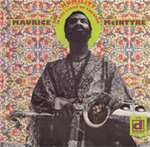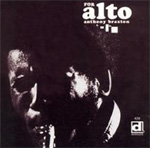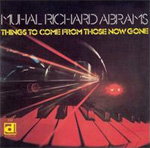| |
35 Years Of Great Black Music : Delmark's AACM Anniversary Reissues
by Scott Hreha
January 2001
The story of the development and institutionalization of the Association
for the Advancement of Creative Musicians (AACM) is well-known to
most followers of the more experimental corners of jazz history. Founded
as an extension of pianist Muhal Richard Abrams' "Experimental Band"
project, which sought to combat the lack of opportunities for forward-thinking
musicians in mid-1960s Chicago, the AACM has endured for over three
decades as a prominent musical and social force in Chicago and throughout
the world.
In fact, the original goal of the meetings that evolved into the AACM
looked to remedy the situation of African American musicians in general
in the wake of the city's desegregation of the musicians' unions—a
misleading victory of the Civil Rights movement that actually resulted
in a loss of jobs as the non-Black union members, who were given first
priority for gigs, earned the ability to cross into the once-forbidden
neighborhoods on Chicago's south side. Upon its recognition as an
official cooperative organization by the State of Illinois in May
1965, the AACM embarked on an ambitious journey to both expose the
South Side's predominantly African American residents to their decidedly
non-commercial music and to help them reach a better understanding
of their heritage through a myriad of educational programs.
In retrospect, it seems difficult to conceive of anyone premeditating
the impact the AACM would have on the face of jazz and other creative
music. However Bob Koester, owner of the still-fledgling Delmark blues
label, refused to balk at the chance to preserve the collective's
activities after being hipped to their existence by his associates
Terry Martin and Chuck Nessa. Koester offered saxophonist Roscoe Mitchell
a recording date—which resulted in his Sextet's declarative
AACM masterpiece Sound—and the rest is, as they say,
history.
To celebrate the organization's 35th anniversary, Delmark has reissued
their three remaining AACM recordings on CD along with a retrospective
of early and previously unreleased material by trumpeter Malachi Thompson—effectively
making available the final pieces of the collective's initial history.
Kalaparusha Maurice McIntyre's Humility in the Light of the Creator,
Anthony Braxton's For Alto and Muhal Richard Abrams' Things
To Come From Those Now Gone fill in the last holes of the original
members' hometown production, giving a more complete picture of the
AACM's aesthetic before several of its members' permanent relocations
to points across the globe.
 The
earliest of these sessions, Humility in the Light of the Creator,
represents the first recording as a leader of (soon-to-be Kalaparusha)
Maurice McIntyre, a tenor saxophonist and clarinetist who had previously
breathed some necessary fire into the spatial explorations of Roscoe
Mitchell's Sound. The session is split into two side-long suites
with slightly different personnel: "Suite: Ensemble Love"—which
features the wordless vocals of George Hines out front with McIntyre
over a two-bassist, two-drummer rhythm section—and "Suite: Ensemble
Fate"—which replaces Hines with trumpet, soprano sax and piano
to achieve an unbelievably huge ensemble sound. Each configuration
has its merits—whether in "Ensemble Love"'s pounding jungle
of sub-Saharan dreamscapes (see "Kacb Emoh") and appropriately humble
melodies that swell into subdued, yet burning climaxes (see "Humility
in the Light…"), or in "Ensemble Fate"'s more cohesive, blissfully
skyward-bound collectivity. The
earliest of these sessions, Humility in the Light of the Creator,
represents the first recording as a leader of (soon-to-be Kalaparusha)
Maurice McIntyre, a tenor saxophonist and clarinetist who had previously
breathed some necessary fire into the spatial explorations of Roscoe
Mitchell's Sound. The session is split into two side-long suites
with slightly different personnel: "Suite: Ensemble Love"—which
features the wordless vocals of George Hines out front with McIntyre
over a two-bassist, two-drummer rhythm section—and "Suite: Ensemble
Fate"—which replaces Hines with trumpet, soprano sax and piano
to achieve an unbelievably huge ensemble sound. Each configuration
has its merits—whether in "Ensemble Love"'s pounding jungle
of sub-Saharan dreamscapes (see "Kacb Emoh") and appropriately humble
melodies that swell into subdued, yet burning climaxes (see "Humility
in the Light…"), or in "Ensemble Fate"'s more cohesive, blissfully
skyward-bound collectivity.
McIntyre would go on to become one of the AACM's most underground
legends, recording only a handful of dates as a leader (including
another for Delmark—Forces and Feelings) before disappearing
for most of the 80s and 90s. His late 90s resurfacing in Bright Moments
(see Return of the Lost Tribe, also on Delmark) and as a leader
(on CIMP's Dream of ----) proved that neither age nor a lack
of opportunities had tempered his gruffly ecstatic improvisations.
 Anthony
Braxton's For Alto is perhaps best known as the record that
sprouted the now-prevalent genre of solo saxophone recordings. Solo
performance was a tenet of the AACM philosophy from the outset—the
idea being that anyone who could produce an interesting and coherent
musical statement without the interaction of others would only be
that much stronger a player in an ensemble setting. However, Braxton
was the first member to put forth any solo work, collecting a series
of home recordings for the second Delmark release under his name.
As fantastically raw as many of the legendary ESP-Disk sessions that
helped to document the New York free jazz scene of the 60s, For
Alto is important not only for its lo-fi utilitarianism, but also
for its revealing glimpse into the early stages of Braxton's development
as a composer. Anthony
Braxton's For Alto is perhaps best known as the record that
sprouted the now-prevalent genre of solo saxophone recordings. Solo
performance was a tenet of the AACM philosophy from the outset—the
idea being that anyone who could produce an interesting and coherent
musical statement without the interaction of others would only be
that much stronger a player in an ensemble setting. However, Braxton
was the first member to put forth any solo work, collecting a series
of home recordings for the second Delmark release under his name.
As fantastically raw as many of the legendary ESP-Disk sessions that
helped to document the New York free jazz scene of the 60s, For
Alto is important not only for its lo-fi utilitarianism, but also
for its revealing glimpse into the early stages of Braxton's development
as a composer.
While it's impossible to escape an acknowledgment of Braxton's instrumental
abilities, especially in the context of his introduction of extended
techniques that would be subsequently embraced by the architects of
the European improv movement, the coherency of his compositional framework
in such a minimal setting proves to be the disc's most impressive
trait. From the brutal intensity of "To Composer John Cage" (an odd
tribute to someone notorious for working with silence) to the cyclical
repetitions of "Dedicated to Ann and Peter Allen" and "Dedicated to
multi-instrumentalist Leroy Jenkins" to the iconoclastic swing of
"To pianist Cecil Taylor", Braxton creates a program of meticulously
constructed patterns and dynamic tensions that foreshadow his more
bombastic larger ensemble work of the 70s and 80s. To be sure, there
are moments throughout the double LP-length disc that are difficult
to endure due either to sound quality or just plain overextension,
but the disc's historical relevance far outweighs any minor criticisms.
 Things
To Come From Those Now Gone can possibly be taken as a kiss goodbye
from the AACM's first president to his hometown. Even though Muhal
Richard Abrams was one of the few core members to stay when most expatriated
to Paris in late 1969, he did permanently leave Chicago for New York
City in the mid-70s. Reflected through nostalgia-tinged song titles
like "Things To Come From Those Now Gone", "In Retrospect" and "March
of the Transients", this disc prefigures Abrams' imminent departure
with a collection of small group pieces that feature a revolving cast
of comrades. Things
To Come From Those Now Gone can possibly be taken as a kiss goodbye
from the AACM's first president to his hometown. Even though Muhal
Richard Abrams was one of the few core members to stay when most expatriated
to Paris in late 1969, he did permanently leave Chicago for New York
City in the mid-70s. Reflected through nostalgia-tinged song titles
like "Things To Come From Those Now Gone", "In Retrospect" and "March
of the Transients", this disc prefigures Abrams' imminent departure
with a collection of small group pieces that feature a revolving cast
of comrades.
Due to the shifting personnel, it's difficult to nail down a particular
mood for the session, perhaps indicative of an uncertainty on Abrams'
part as to which compositional road he intended to follow next. The
moods, particularly in the five short pieces that comprise the first
half, range from austere ("Ballad For New Souls", "How Are You", "Ballad
For Old Souls") to energetic ("Things To Come…" and "In Retrospect")
without seeming to fully commit to either. The second half's longer
pieces are slightly more fleshed-out than their predecessors: "1 and
4 Plus 2 and 7" finds Abrams concocting Sun Ra-like synthesizer space
chords and radar waves under the blessings of Steve McCall's minimal
percussive accents and "March of the Transients" captures the telltale
elements of what would become Abrams' signature compositional style—jittery
angles merged with uptempo rhythm, executed with impeccable precision.
 Malachi
Thompson's Timeline is both the oddest and most patched together
release of the reissue batch. Compiling material that represents 16
years of the trumpeter's career, the disc proves to be a bit inconsistent
in the end analysis. The earliest pieces show an electric-based sound
that flirts with soul jazz and fusion without compromising its bop
integrity—the most curious results being "The Ali Shuffle",
a boogie-down blues groove complete with handclaps and chanted group
vocals in tribute to Muhammad Ali. However, the later tracks offer
some truly bright moments—like the freebop (a term coined by
Thompson) call and response of "They Stole Einstein's Brain" and the
high-energy, militaristic tensions of "Ghost Guest". Although Thompson
is a minor figure in the AACM legacy in comparison with McIntyre,
Braxton and Abrams, his eclectic sensibilities demonstrate just how
far-reaching a scope the organization embraces. Malachi
Thompson's Timeline is both the oddest and most patched together
release of the reissue batch. Compiling material that represents 16
years of the trumpeter's career, the disc proves to be a bit inconsistent
in the end analysis. The earliest pieces show an electric-based sound
that flirts with soul jazz and fusion without compromising its bop
integrity—the most curious results being "The Ali Shuffle",
a boogie-down blues groove complete with handclaps and chanted group
vocals in tribute to Muhammad Ali. However, the later tracks offer
some truly bright moments—like the freebop (a term coined by
Thompson) call and response of "They Stole Einstein's Brain" and the
high-energy, militaristic tensions of "Ghost Guest". Although Thompson
is a minor figure in the AACM legacy in comparison with McIntyre,
Braxton and Abrams, his eclectic sensibilities demonstrate just how
far-reaching a scope the organization embraces.
Fortunately, Delmark didn't stop recording AACM artists when the collective's
first chapter came to a close; in fact, the label has been and continues
to be one of the most consistent sources for AACM music in the world.
But, as these reissues testify, the still-independent label was there
from the very beginning—charting the AACM's innovative course
nearly every step of the way.
|
|
|
|
|

